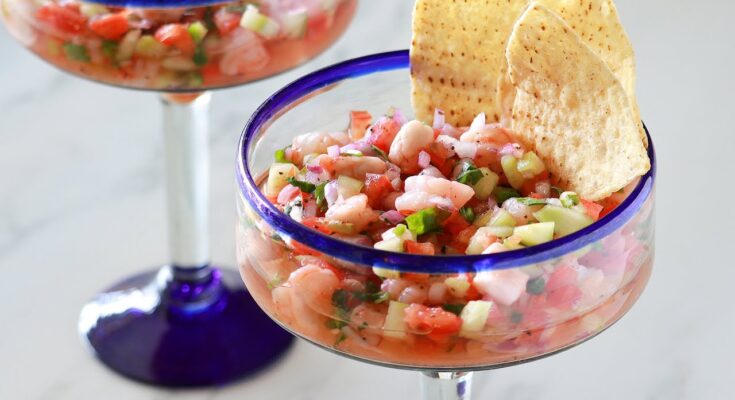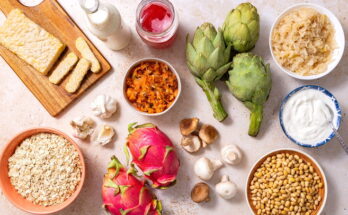Ceviche Recipe: Ceviche is a fresh, flavorful, and citrusy seafood dish with origins in Latin America, especially Peru. It has become a favorite across the globe due to its vibrant flavors and healthy profile. Whether you’re hosting a summer gathering or craving something light for lunch, ceviche is the perfect choice. With just a few ingredients and simple steps, you can recreate this refreshing dish at home. Plus, it’s naturally gluten-free, packed with lean protein, and bursting with flavor.
Let’s dive into a step-by-step guide to making the perfect ceviche!
What is Ceviche?
Ceviche is a dish made with raw seafood that is marinated in citrus juice (usually lime or lemon). The acidity from the citrus ‘cooks’ the fish without any heat, resulting in a tender and flavorful seafood dish. Traditionally from Peru, ceviche has now spread across the Americas, with many regions adding their own spin. Classic ceviche features diced fish, onions, cilantro, and chili peppers, but you’ll find endless variations to explore.
Ingredients Required for Classic Ceviche
Here’s what you’ll need to get started:
- Fresh white fish (such as sea bass, snapper, or halibut) – 1 lb
- Fresh limes – 8-10 (enough for 1 cup of juice)
- Red onion – 1 (thinly sliced)
- Fresh cilantro – ¼ cup (chopped)
- Jalapeño or serrano chili – 1-2 (finely chopped)
- Salt and pepper – to taste
Optional Add-Ons:
- Diced tomatoes
- Avocado chunks
- Mango or pineapple for a tropical twist
Choosing the Right Fish for Ceviche
Using fresh, high-quality fish is crucial to making great ceviche. Some of the best fish for ceviche include:
- Sea bass
- Snapper
- Halibut
Alternatively, shrimp, scallops, or octopus can replace fish. Be sure to choose firm-textured seafood that holds up well in the citrus marinade. Always look for fish that smells clean and has shiny skin.
Essential Tools You’ll Need
- Sharp knife for slicing the fish
- Citrus juicer for extracting lime juice
- Mixing bowl
- Cutting board
- Plastic wrap
Step-by-Step Guide to Making Ceviche
Step 1: Preparing the Fish or Seafood
Start by rinsing the fish thoroughly under cold water. Use a sharp knife to cut the fish into small cubes (around ½-inch pieces). This ensures the fish will ‘cook’ evenly in the lime juice.
Step 2: Marinating with Lime Juice
Place the fish cubes in a mixing bowl and pour enough freshly squeezed lime juice to cover the fish completely. The citrus juice will begin ‘cooking’ the fish almost immediately.
Step 3: Adding Vegetables and Seasoning
Mix in thinly sliced red onion, chopped cilantro, and chili peppers. Add salt and pepper to taste. This is the stage to incorporate any optional ingredients like diced tomatoes or avocado.
Step 4: Letting it Sit
Cover the bowl with plastic wrap and refrigerate for 15-30 minutes. You’ll know the fish is ready when it turns opaque and firm.
Step 5: Serving the Ceviche
Give the mixture a final stir, taste, and adjust seasoning if necessary. Serve immediately with tortilla chips or tostadas for a delightful appetizer or meal.
How Long Should You Marinate Ceviche?
For most white fish, 15 to 30 minutes is ideal. Marinating for too long can result in a rubbery texture. If you’re using shrimp or scallops, adjust the marination time accordingly (about 30-45 minutes).
Tips for Perfecting Your Ceviche
- Balance the flavors: Ensure the citrus, salt, and spice are well-balanced.
- Don’t over-marinate: Longer marination will make the fish tough.
- Use fresh limes: Bottled lime juice won’t provide the same fresh flavor.
Common Mistakes to Avoid
- Using frozen fish: Fresh fish always delivers the best results.
- Over-marinating: Keep an eye on the fish to avoid an overly tough texture.
- Excess liquid: Drain any extra liquid before serving for the best presentation.
Variations of Ceviche
- Shrimp Ceviche: Use peeled shrimp instead of fish, with the same marinating process.
- Tropical Ceviche: Add diced mango or pineapple for sweetness.
- Spicy Mexican Ceviche: Incorporate more chilies and tomatoes.
How to Serve Ceviche
Ceviche is best served chilled. You can pair it with:
- Tostadas or tortilla chips
- Sweet potato slices
- Lettuce cups for a lighter option
Pairing Drinks with Ceviche
- Beer: A light lager complements the citrusy flavors.
- White wine: Try a crisp Sauvignon Blanc.
- Non-alcoholic: Agua fresca or lemonade is refreshing.
Is Ceviche Safe to Eat?
Yes, but always use the freshest seafood available to minimize risks. Pregnant women and those with compromised immune systems should avoid raw seafood.
Storage and Leftover Tips
Ceviche is best eaten fresh but can be stored in the refrigerator for up to 24 hours. Avoid freezing as it changes the texture.
FAQs about Ceviche Recipe
What is ceviche?
Ceviche is a popular dish in Latin America made primarily from fresh raw fish cured in citrus juices, predominantly lime or lemon, and spiced with chili peppers. Additional seasoning may include onions, salt, and cilantro.
What type of fish is best for ceviche?
The best fish for ceviche are firm, fresh fillets like tilapia, halibut, or sea bass. It’s crucial to use only the freshest fish since it will be eaten raw.
Is it safe to eat raw fish in ceviche?
Yes, it is safe to eat raw fish in ceviche as long as it is fresh and properly handled. The acidity from the lime or lemon juice helps to “cook” the fish without heat, killing bacteria and parasites.
How long should fish marinate in lime juice?
Typically, fish should marinate in lime juice for about 15 to 30 minutes. The exact time can vary based on the thickness of the fish pieces. The fish is ready once it becomes opaque and firm.
Can you make ceviche with frozen fish?
Yes, you can use frozen fish for ceviche. Ensure it’s thoroughly thawed and of high quality. Freezing can help kill any parasites, making it a safer option for raw consumption.
What are some common accompaniments to ceviche?
Ceviche is often served with sides that complement its flavors, such as sweet potato, lettuce, corn, or plantain chips. Avocado slices are also a popular addition.
How long can you keep ceviche in the refrigerator?
Ceviche should be consumed fresh, ideally within a few hours after preparation. If refrigerated, it should be eaten within 24 hours to maintain the best quality and safety.
Conclusion
Mastering the art of preparing ceviche at home can transform your culinary skills and elevate your dining experience. The beauty of ceviche lies in its simplicity and the freshness of its ingredients. Once you’ve grasped the basic technique—marinating fresh seafood in citrus juices—the possibilities become endless. Each variation you try adds a new layer to your cooking repertoire, encouraging a delightful exploration of flavors.
I encourage you to experiment with different types of fish, citrus, and add-ins. Whether you incorporate tropical fruits for a sweet twist or add fiery peppers for a kick, each version of ceviche you create will be uniquely yours. So, dive into the refreshing world of ceviche, and let your culinary creativity flourish!
References
For those keen on delving deeper into the art of making ceviche and exploring its cultural significance, here are some authoritative sources that offer a wealth of information:
- Serious Eats – This culinary website provides a comprehensive guide on how to prepare traditional ceviche, complete with expert tips for selecting the freshest fish and achieving the perfect citrus balance.
- Epicurious – Known for its extensive collection of recipes and cooking techniques, Epicurious offers variations of ceviche recipes from different parts of the world, allowing readers to experiment with global flavors.
- Food & Wine – For those interested in the pairing of beverages with ceviche, Food & Wine offers insights on the best wines and cocktails that complement the dish’s vibrant flavors.
Each of these sources is renowned for its culinary expertise and provides valuable insights for both novice and experienced cooks. Exploring these links can enhance your understanding of ceviche, ensuring your next dish is as authentic and delicious as possible.



